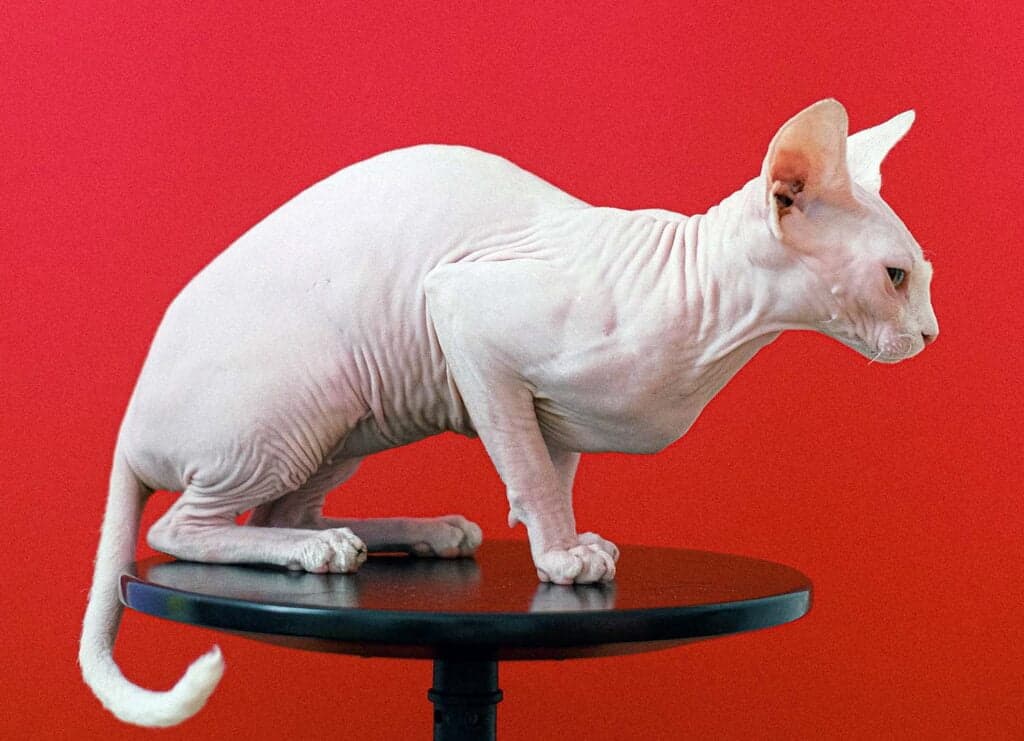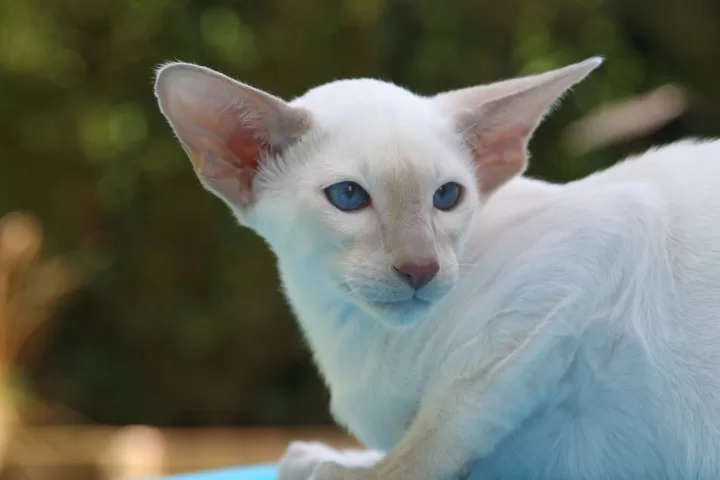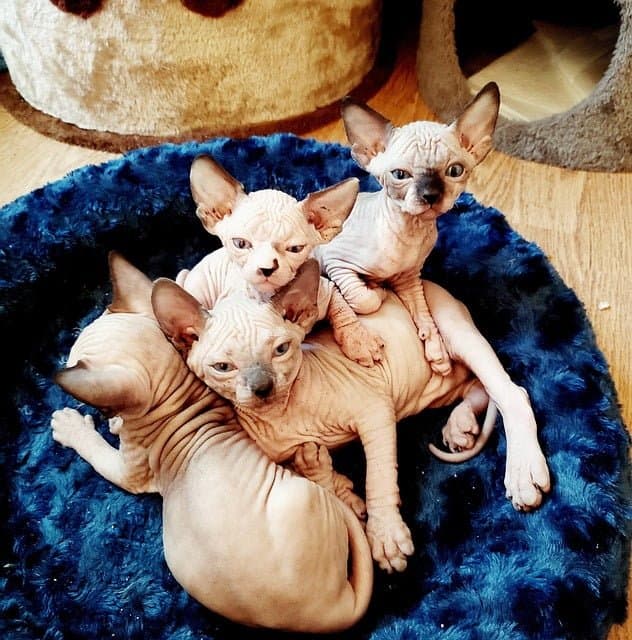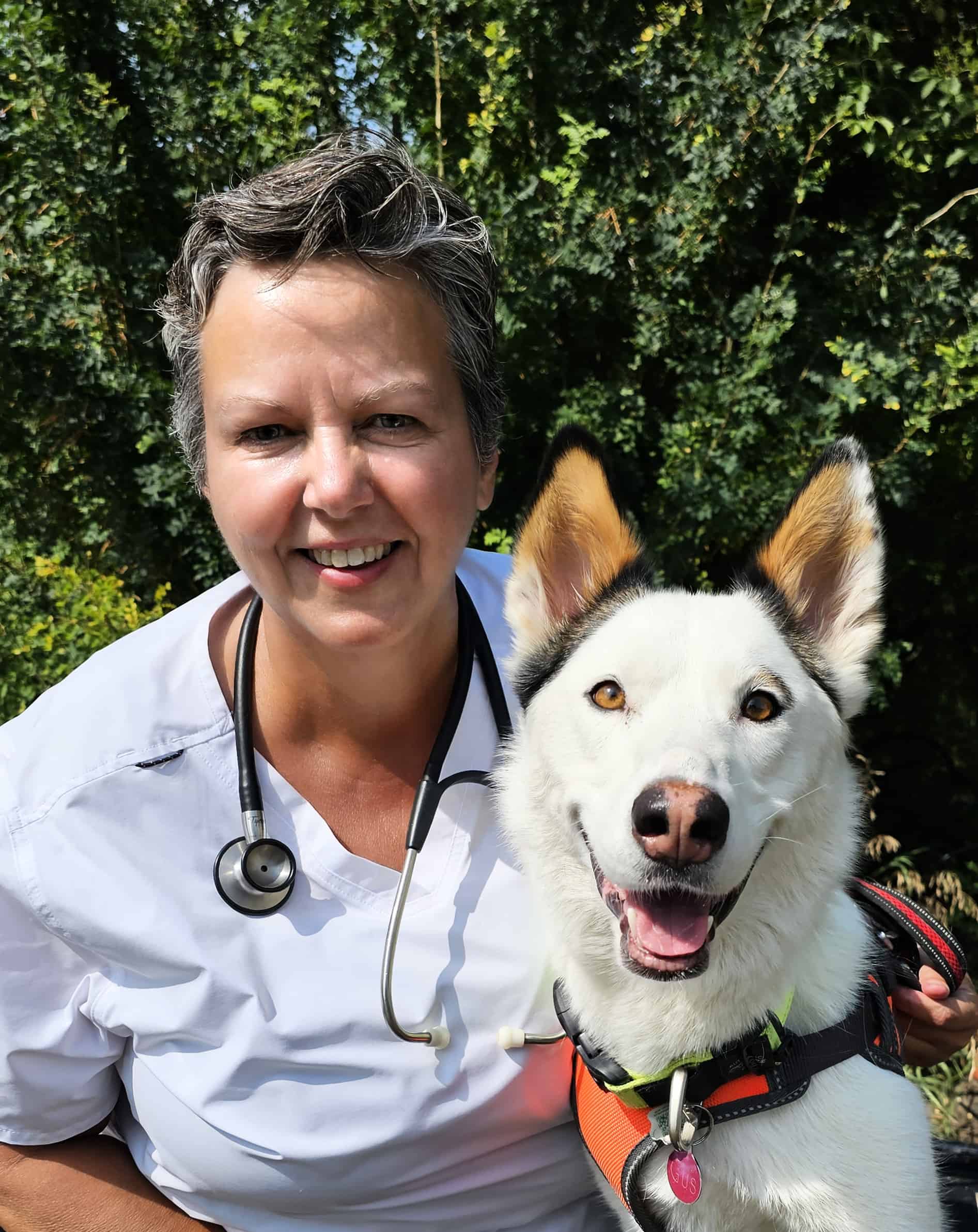I love cats. I usually have a cat companion or two around. However, I did go through a few years recently with no cats in the house and I have to admit – I got used to not having cat hair everywhere!
Then I met a hairless Sphynx cat who convinced me that I could have a cat and not end up with a fur-covered house. If you are like me and love cats but not all their hair, you may be wondering what the options are for low-shedding or non-shedding cats.
The best options for non-shedding cats are hairless cats, like the the Sphynx, Donskoy, Bambino, Peterbald, Elf, and Ukrainian Levkoy breeds. If you don’t mind a bit of shedding, the Devon Rex, Cornish Rex, Minskin, and Singapura are good options also.
If you are considering getting a new cat and are looking for one that doesn’t shed, then this article is for you. Read on to learn more about these unique and wonderful breeds of cats.
No Cat Breeds Are 100% Non-Shedding
First things first – you will rarely find a cat that absolutely sheds NO hair, ever. Even the “hairless” breeds usually have fine, downy hair that gets shed at some point. You just won’t notice it very often, since it is so fine and so short.
Furthermore, low-shedding cats – even “hairless” breeds – are NOT hypoallergenic. They still shed dander (dead skin) and they still produce Fel d 1, the protein produced in saliva and in the skin which is responsible for causing allergies.
Now that we’ve established those little facts, let’s talk about non-shedding or low-shedding cat breeds.
Hairless Breeds
Hairless cats are not truly hairless. They usually have, at minimum, a fine coat of hair that is soft, downy, and very short. Often, it is not even really visible until one gets very close to the cat or views it with light behind it.
This fine downy fur can be thicker or thinner at different times of the year. I brought my Sphynx rescue home during the summer, and she was at her most hairless at that point. Now, mid-winter, she is covered by a fine down with a few thicker areas.
Some individuals among hairless breeds may have patches of hair. Tufted tails and fur ruffs are not uncommon. Sometimes the hair on these cats can thicken and fill in quite a bit during winter, and revert back to a mostly hairless state for summer.
While hairless cats do not require regular brushing, their maintenance needs are not low. They require regular bathing to help keep the oils in their skin at a healthy level. They also need to be kept indoors and away from cold temperatures, since they have no fur to keep them warm.
Sphynx Cats

The Sphynx cat, also known as the Canadian Sphynx, is probably the most popular and widely recognized hairless breed.
This breed of cats is relatively new and has its origins traced back to Ontario, Canada, and Minnesota, USA. The hairless appearance is caused by a mutation in the same gene that is responsible for the soft, curly coat of the Devon Rex breed.
Sphynx cats are renowned for their affectionate and loyal nature, forming strong bonds with their owners. They crave human attention and love to snuggle and cuddle in laps.
With an excellent memory and sharp intelligence, Sphynx cats learn commands quickly; they also enjoy puzzles, interactive toys, and exploring new spaces. They have high energy and need ample opportunity to play and exercise.
Donskoy Cats

The Donskoy cat, a.k.a. the Don Sphynx or Russian Hairless cat, very much resembles the Canadian Sphynx. However, it is not the same, as its hairless state is a result of a different genetic mutation.
The cats are medium size and have a muscular build. They have large ears and almond-shaped eyes. Very active and highly intelligent, these cats are also very gentle and amiable. They love socializing and interacting with their owners, making them easy to groom and handle.
There are some concerns that the genetic mutation that results in their hairlessness could lead to feline ectodermal dysplasia, resulting in problems such as poor teeth and the inability to sweat or produce milk.
Bambino Cats
Bambino cats are a result of the crossing of cats from the Sphynx and Munchkin breeds. This hybrid breed is known for its petite size and short legs.
While most major cat registries don’t acknowledge the Bambino as a breed due to concerns over health issues resulting from their genetics, the breed has gained some recognition.
In 2005, The International Cat Association (TICA) recognized the Bambino as an experimental breed, with some countries prohibiting their breeding due to genetic health concerns. They’re also accepted by the Rare and Exotic Feline Registry (REFR).
Bambinos have a short, athletic build and an outgoing but gentle disposition. These cats are intelligent, interactive, and affectionate; their small size does not stop them from being agile and energetic. Being very social, they enjoy being around people and respond well to being handled.
Peterbald Cats

The initial Peterbald is a result of crossing a Donsky cat and an Oriental Shorthair cat, which yielded a hairless cat that otherwise is very characteristic of the Oriental Shorthair. The breeding program encouraged crosses with Oriental and Siamese types to maintain the Oriental look.
The Peterbald coat can range from completely hairless to a full coat, depending on the individual’s genetics.
Peterbald cats are a friendly and fun breed, ideal for those looking for lots of love and attention. Their level of loyalty is remarkable – often compared to canines – and they get along wonderfully with other animals (cats included), children, and visitors alike.
Peterbalds are highly intelligent and always ready for new adventures or games of fetch. They are also very curious and tend to explore every corner of their kingdom.
Elf Cats
Elf cats are a friendly and intelligent breed prized for their enchanting appearance and personalities. They are the result of crossing a Sphynx with an American Curl, combining the hairless feature of the former with the curled ears of the latter.
This breed is not recognized as an official breed and is currently only considered an experimental cat breed.
Appearance aside, the personality of the Elf is most like its Sphynx parent, being affectionate and people-oriented. They have a playful nature and enjoy interactive toys, games of fetch, and other entertaining activities.
Those who choose this breed can look forward to having a loving companion that enjoys being around its humans. Elf cats also have a reputation for being gentle and sweet-natured yet energetic and full of life.
Ukrainian Levkoy
The Ukrainian Levkoy is a rare breed of cat that was developed in Ukraine and has since become increasingly popular across Europe.
This breed is a recent introduction onto the cat scene, created in the early 2000s through the crossing of hairless Donskoy queens with Scottish Fold toms. The result is a nearly hairless cat with folded ears.
This breed has received some recognition from the Ukrainian and Russian cat breed associations but is otherwise considered an experimental breed.
The Ukrainian Levkoy breed of cats are known for their friendly, playful, and intelligent nature. They enjoy the company of humans, as well as other domestic pets.
Being hairless, they don’t require brushing but like other hairless breeds, they do require regular bathing and protection from the sun and cold weather.
Short Coat Breeds
There are several breeds of cats that, while not hairless, do have less hair to shed than most cats do. These cats have either very short coats or else they are missing the other layer of guard hairs and thus have just that much less hair to shed.
Devon Rex

The Devon Rex is known for its soft, curly coat which is often referred to as the “rex” look. This breed has a genetic mutation resulting in an inability to grow the coarser outer guard hairs, leaving them with only the downy softer fur.
These cats have large, slightly rounded ears and large eyes. Their genetic mutations also affect their whiskers, which are short and crinkly.
The Devon Rex is a friendly, active, and playful breed known for its curious nature. They are known to be curious, and intelligent – often learning tricks quickly.
The unusual coat of this breed means minimal shedding, making them a great choice for those who don’t want to deal with the hassle of continuously cleaning up after stray hairs.
Cornish Rex

The Cornish Rex is a breed of cat known for its curly and wavy coat. This is another breed that has a genetic mutation that prevents the growth of guard hairs, although it is a different mutation than that of the Devon Rex.
This is a small to medium-sized cat with slender boning that may feel almost dainty. Its unique coat lies softly in waves reminiscent of cornrows and its head is small, but with large ears and eyes.
In terms of personality, the Cornish Rex becomes deeply bonded to its humans and loves spending time with them. Intelligent and highly active, they enjoy interacting and playing with their owners and other household pets.
The Cornish Rex loves jumping, running around, and playing. When it comes to living with this breed, owners should provide enough space for exercise and playtime.
Minskin
The Minskin is a breed created through a combination of the Munchkin, Burmese, Sphynx, and Devon Rex cat breeds. This mix provides a one-of-a-kind look and personality that is truly unique.
Minskin cats are shortlegged with very short hair coats. Their fur is thicker on their points (their mask, ears, legs, and tail). This is a small breed that is known for being playful and affectionate.
Singapura

The Singapura is considered the smallest breed of cat with its defining characteristics being its petite size, big eyes and ears, distinctive ticked coat, and short blunt tail.
The exact lineage of the Singapura breed is unknown but is thought to have Abyssinian, Burmese, and Siamese origins. DNA testing in 2007 revealed that genetically the Singapura is very similar to the Burmese breed.
The Singapura is known for its active, curious, and playful nature and loves attention, and makes a great family pet. They love to climb and perch in high places, and are known for being intelligent and able to learn tricks and commands much like dogs do.
In Summary
These ten breeds are all low-shedding cats that make great family pets. Each breed is known for its own individual look and personality, but all of them share a love for their human companions and an affectionate nature.
Some of them are, of course, more available than others. It will be easier to find a Sphynx, Devon Rex, or Cornish Rex kitten than it will be to find one of the rarer breeds like the Minskin, Elf, or Singapura.
But no matter which breed you choose, you can be sure that it will be a beautiful addition to your family and that it won’t as shed much hair as most other breeds do.


